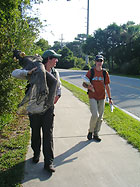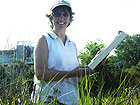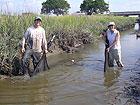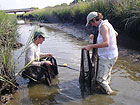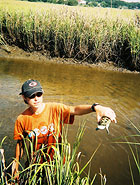

 | |||||||||||||||||
|
|
Journals 2006/2007Anna Hilton
July 19, 2006 (Part 1) Today I was excited for two reasons. We were going to seine Postell Creek, and we were headed back home afterwards. Lisa, Mark and I spent the second day seining each reach to collect samples of fish and invertebrates from Postell Creek. I had done this before when Jennie Moore principal, teachers, and students pulled a seine in a tidal creek near our school to find marine animals for our school touch tank. Kolo had left earlier with Cindy's team hoping to find oysters in the lower order of Burnett Creek. They ran into some problems trying to trawl in very shallow water. Paul's boat was flat bottomed and his experience with it saved their sampling day. All three teams had to retrieve the sondes they had left twenty-four hours earlier.
When our team of three reached Postell Creek, we immediately went to remove the sonde. Mark carefully placed a plastic cap over the delicate probes on the sonde for transport back to HML. We carried the sonde back to the truck and picked up the seine and other gear we needed for biota sampling. Lisa and Mark reviewed the procedures for seining, and I was again impressed with how exactly they followed every procedure. The seine had to be pulled for twelve meters in a straight part of the creek. A pre-measured knotted rope was used to determine twelve meters. Lisa and Mark pulled the seine at the first reach. I stood on the bank recording the time; the width of the marsh from bank to bank; the width of the creek; and the depth of the creek on both sides and in the middle. It was easy because the data sheet was a table with titles by all of the measurements I needed to record. All of the measuring in the creek was done with the rope knotted into meter lengths. Remember in science class we use metric measurement. Scientists always use metric for every measurement so they can communicate their data all over the world! The seine net is pulled together and onto to the bank carefully so that no marine animal caught in the net escaped. It is sad to know that the fish and crabs we catch will give their lives to science research, but it is for a good cause. Hopefully the Tidal Creeks Monitoring and Assessment Project will convince developers that construction near watersheds needs to be planned much more carefully to protect and preserve our coastal ecosystems.
The first seine caught a lot of marsh grass floating on the water along with tiny grass shrimp and minnows. Lisa called for a large plastic bag from my backpack. I took the label with the correct order and reach number and put it in the plastic throwing the bag to Lisa in the creek. I again recorded the width and depth of the water as Mark called out the measurements to me. The second seine was very much like the first. I helped Mark pull the seine.
This time Lisa recorded all the information as Mark and I carefully gathered the nets together without letting any of the fish or crabs escape. A small labeled bag held the sample from this reach.
We ran into an adventure and a pluff mud mess at the final reach. The banks at this reach were very steep so a mud slide to the creek was necessary (fun)! Lisa and Mark measured the twelve meters to pull the seine and I marked beginning and ending with our backpacks up on the bank. The creek was much deeper and wider at this reach. Fish started jumping around Mark as he took one side of the seine across the creek. I started snapping photos hoping to catch a fish in midair. What we did catch was a beautiful diamondback terrapin swimming ahead of the net. Lisa picked it up and I took a photo of it before she carefully let it go.
Another diamondback terrapin immediate swam up when they continued seining. I took another photo and made a note about the turtle. I saw a large fish swimming just ahead of the net making an escape from the intruders- us! We were so excited to see what would be in the seine but the net became hopelessly caught up in the pluff mud as the researchers pulled it up a mud bank toward the end of the twelve meters. We finally had to pull backwards and redo this last seine in another area at the reach. Mark, Lisa, and I were very excited to see all the animal action in the creek and did not mind the delay. Does a healthy creek have more animals? That is the very important question being studied by HML. We are observing and measuring the creeks quantitatively and qualitatively. The quantity we measure is the width and depth of the creek. The quality refers to the analysis of the water in the creek. Do only pollutants or also the amount of fresh water (from rain or river) in the creeks determine the biota in the creeks? Lisa and Mark explain these properties of the creeks to me. The last seine of the day produced a very nasty smell. Lisa and Mark debated whether it was a dead fish or something else. They asked if I wanted to smell the putrid sample but I declined to observe with my nose that time. Lisa laughed and plotted to give the sour sample to a researcher from one of the other teams to process back at the lab. |
||||||||||||||||
